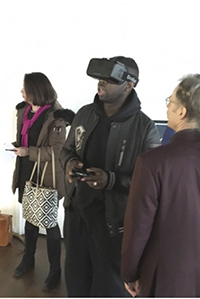
Not a Friend of ASOR yet? Sign up here to receive ANE Today in your inbox weekly!

December 2021
Vol. 9, No. 12
Rethinking Austen Henry Layard
By Stefania Ermidoro
When every scholar of the ancient Near East hears the name Austen Henry Layard (1817-1894), they immediately think of Nineveh. Indeed, Layard’s fame is inextricably linked to the discovery of that ancient Assyrian city – even though such merit should actually be attributed to others, namely Claudius James Rich, who first provided accurate topographical data for its identification, or Paul Émile Botta, who carried out the earliest extensive excavations on the site. In fact, Layard may be credited with the discovery of ancient Kalhu or Nimrud– but his lengthy book Nineveh and Its Remains cemented his association with that site.
Layard deserves to be reconsidered today in light of his varied and multifaceted personality, which can hardly be classified under the single category of ‘archaeologist.’ He was a typical polymath of early Victorian England: traveler, archaeologist, politician and diplomat, writer, art collector, and scholar. He did not belong to the British upper class by birth. Instead, he was born in Paris to a civil servant father, was educated in Italy, France and Switzerland and finally in London by his uncle, who wanted him to become a barrister.
In 1839 Layard took the first steps to become the architect of his own destiny when he embarked on a journey that would change the course of his life. Together with Edward Ledwich Mitford, he set out for Ceylon, but in the summer of 1840 the two travelers took different routes, and Layard obtained an unpaid commission from the British Embassy in Constantinople. From there Layard spent many months alone in Persia and on other diplomatic missions.
In a continuous attempt to be noticed, Layard understood that archaeology was a rising field and foresaw the revolutionary potential of a large excavation in the East. In 1845, he set out to dig an archaeological site that had caught his eye – the mound of Nimrud, south of Mosul. The official vizierial permit, however, was obtained through the British Ambassador to the Ottoman Empire, Stratford Canning, only in the summer of 1846. His many discoveries at Nimrud and elsewhere – including the Library of Ashurbanipal and the palace of Sennacherib – proceeded to astonish the world.
Thanks to the discoveries he made in Assyria, Layard gained so much fame that he decided to abandon archaeology in 1851, after just seven years of active excavations. He returned to England and began a political career: elected as a Member of Parliament in 1852, he later held ambassadorships in both Madrid (1869-1877) and Constantinople (1877-1878). Indeed, it should be noted that while Rich and Botta were active in Mesopotamia as diplomatic representatives of their respective countries, Layard accessed diplomacy the opposite way: he first became an archaeologist in order to be admitted to the political world.
In his homeland, Layard soon became the epitome of the adventurer whose initiative, perseverance and ingenuity allowed him to make great discoveries and overcome uncomfortable circumstances. He built on this perception by delivering a series of speeches about ancient and modern Assyria to universities, assemblies of working men, and in open gatherings held in theatres and other large venues. Popular interest was further enhanced by the lack of previous information about Nineveh: knowledge about Assyria only came from excerpts by classical authors or the Old Testament. Thus, when Layard was awarded the Freedom of the City of London in 1853, he was credited to have demonstrated “the accuracy of Sacred History.”

One example of archival materials recently rediscovered and studied: red folder containing Layard’s proofs and drawings for A Second Series of The Monuments of Nineveh (London 1853). Newcastle University Library, Layard Archive.
Because of his achievements, research on Layard risks becoming a mere celebration of his singular personality, strongly conditioned by the image that Layard himself was careful to convey. Indeed, publications that appeared in the second half of the twentieth century – including Layard’s biography by Gordon Waterfield in 1961 – essentially idealize Layard’s deeds. During his life Layard wrote books on his adventures in the East, published drawings and inscriptions found in the excavations, and even published books and pamphlets on completely different topics, such as Italian art and history, the Huguenots, and the Crimean War. His private archives include other unpublished manuscripts, autobiographical accounts, and speeches presented in the House of Commons and then the House of Lords.
Recent reassessments of Layard have mostly focused on the political implications of nineteenth century archaeology, highlighting its imperialistic aspects and considering him as an officer engaged in a form of nationalist enterprise, whose achievements were used to inflate England’s glory and self-esteem. But the multifarious aspects of Layard’s work coexisted throughout his life, across his brilliant career from an unpaid attaché at the Embassy in Constantinople to the role of Ambassador in that same city some 35 years later.
To write an unbiased history of the rediscovery of Assyria and Layard’s own personality, recourse is now being made to archival materials. Relevant documents are found in several archives, especially the British Library and the British Museum, but also in The National Archives at Kew, the John Murray Archive (National Library of Scotland), as well as in other smaller repositories across the UK. From these papers it clearly appears that Layard was a pioneer and supporter of archaeology in a very broad sense.
Not only did he participate in the foundations of Assyriology (by contributing to the work of Henry Creswicke Rawlinson, Edward Hincks, Edwin Norris and others), but also to the pre-classical archaeology of Anatolia. Layard had active exchanges with pioneering Assyriologist Archibald Henry Sayce, and supported excavations at various sites: obtained vizierial permits for Heinrich Schliemann’s excavations at Hissarlik and in other Eastern regions such as Cyprus, as his correspondence with Emilius Clayton and Luigi Palma di Cesnola demonstrates.
Layard’s contribution to the creation of the Assyrian collections at the British Museum is renowned: he shipped to London thousands of inscribed clay tablets and bricks, marble reliefs, cylinder seals and pieces of jewelry. He also kept a few objects for himself, and donated others to friends and relatives. A few collections across Europe today include items connected to Layard: these were among the very first Assyrian objects ever displayed in Venice, Lausanne, Munich and other European cities. Layard also discussed Assyria-related topics with high-ranking politicians and crowned heads from all over the world, as attested by newspaper articles and private letters. Thus, he actively contributed to the dissemination of knowledge about the archaeology of the ancient Near East in its early days and at every level of society.
Throughout the second part of his life, as a politician and diplomat, Layard was never entirely rid of his archaeological fame. In Parliament, he was jokingly referred to as the “Member from Nineveh” and his relationship to Assyria was never forgotten by the periodical press. He was often referred to as “Mr Bull,” to recall both the monumental statues he had uncovered and John Bull, that is, the cartoonish personification of Great Britain itself. This also explains the caricatures that appeared in the journal Punch, where Layard is mostly represented as a personification of an Assyrian-style bull – both in positive terms, as in the 1855 image where he appears rampaging and threatening his opponents in Parliament, but also as a criticism of his tactlessness regarding the Eastern Question, as in an 1880 caricature where he appears as the “Bull in the China shop.”
Layard today should be freed from idealization and reconsidered in the light of the many roles he played in the course of his life. The most recent studies are sense encouraging: they enlighten a complex and multifaceted character, who played a crucial part in the social, cultural and political life of his time.
Stefania Ermidoro is a Post-Doctoral Research Fellow in the Department of Humanities at Ca’ Foscari University of Venice.
Want To Learn More?
Nimrud Rising: An Immersive Virtual Reality Recreation of a Lost Site
By Peter Herdrich
In March, 2015, reports from the Iraqi Ministry of Tourism and Antiquities confirmed that agents of the Islamic State in Iraq and Syria (ISIS) had attacked the ancient Assyrian capital city of Nimrud in northeastern Iraq, just eighteen miles southeast of Mosul. Read More
 World War I and Archaeology in Iraq
World War I and Archaeology in Iraq
By Lamia Al Gailani Werr
It is ironic that I am writing this article on the centenary of the First World War, while Iraq today is suffering from turbulence that is partly the consequence of that war. Iraq was created by Britain out of the remains of three Ottoman provinces. Read More

